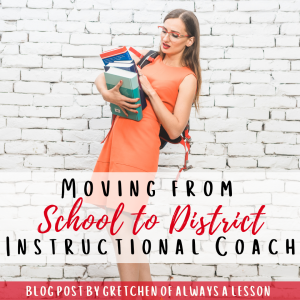Moving from School to District Instructional Coach
Moving from a school to district instructional coach can be an adjustment for educators. There are many similarities and differences between the roles. This post will outline those as well as provide overall tips for making the transition successfully.
 Similarities in Roles
Similarities in Roles
- Purpose– Instructional coaching, whether at a school building or district level, is the same- support the growth of teachers and students.
- Skills– How coaches coach an individual teacher remains the same- listen, make suggestions, provide resources, be available, give feedback, practice specific skills, etc.
- Impact– Working with a teacher and positively impacting their classroom of students is a powerful perk of instructional coaching. Each additional classroom working with a coach receives the benefit of outside perspective and strong instructional experience. This happens regardless if it’s only a single school or an entire district. The impact multiplies success.
Differences in Roles
- Focus– The district may have a different focus for coaching than an individual school building had. Understanding how the coaching position is to be utilized prior to transitioning will ensure a coach can best prepare for the focus shift.
- PLN– Without a single home base, it can be difficult to enmesh into a school community. You will no longer spend all of your time in one place with the same group of people. Learning to build relationships and make allies throughout the district ensures your PLN remains strong and helpful.
- Time– Commuting between schools takes time out of the school day where you could be physically meeting with teachers. District coaches have to get creative in how to support teachers virtually (social media apps, various communication tools, email, text, phone, etc.) so that even when commuting they are still serving teachers. It is important to plan your days, weeks, and months intentionally. This ensures you maximize time at every campus and can be available to teachers even when you are not physically there.
- Space– When a coach supports multiple campuses, they may or may not have their own space (ie. office) to work out of. They may have a coat closet, a niche under the stairwell, a cart, or some other common place to use while in a particular building. [See past blog post on Coach Life: Not Having a Home Base.] Organization and efficient systems help district coaches travel with a lighter load and work effectively out of various spaces throughout the district’s schools. [See past blog post on Getting Organized as an Instructional Coach.]
Tips for the Transition
- Chat with the Coordinator– Whomever is in charge of district level instructional coaches, is someone who can answer all of your logistical questions. Be sure to get all the details for your role cleared up before beginning. Hold on to their contact information as you will probably need to get in touch with them throughout the year.
- Meet with Building Principals– Drive to each school you will support and meet the principals. You do not need to have a lengthy meeting, but it’s essential to put faces to names. Any other communication can occur over email or phone if need be. But make the introduction in person and get a lay of the land so you know where to park, how to enter, where to work out of, etc.
- Introduce Yourself to Staff– You most likely are working with specific staff members rather than the entire staff. Receive a roster so you know who you are supporting at each school site. Meet each teacher in person, even if just a quick “hello.” Leave them with your contact details (ie. a business card) so they can reach you when they need to. You’ll want to see the location of their classroom at this point in time as well. Answer any questions they might have. (You can do a smaller version of “Cupcakes with Coach” and have all the teachers you support come to a central location to meet you. I also suggest visiting their classrooms so you know how to get there and what the general set up is like. This will help your feedback be as accurate as possible for the setting.)
- Get Organized– Having all of your resources accessible online helps limit what you are carrying with you into each school. Any physical items can be placed in a rolling cart or bag to not hurt yourself lugging it around. Ensure you can access any remote resources at each school site. Having folders per building and per teacher should help you stay organized.
- Coach and Adjust– Once you have prepared, it’s time to get coaching. Make adjustments as necessary to ensure you are timely, productive, and effective when at schools working with teachers. Let staff know you are figuring out your systems and get their feedback on how things are going. Reflect and adjust as needed.
Moving from school to district instructional coach is an honor! It can feel daunting but after reading this post you are now prepared for the transition. You will love widening your net of impact!
If you are in need of instructional coaching resources, browse them here.
GO BE GREAT!


 Get Edu-Tips, Freebies and grab your FREE Study Guide for Gretchen’s New Book!
Get Edu-Tips, Freebies and grab your FREE Study Guide for Gretchen’s New Book!